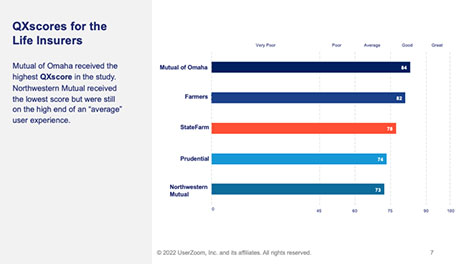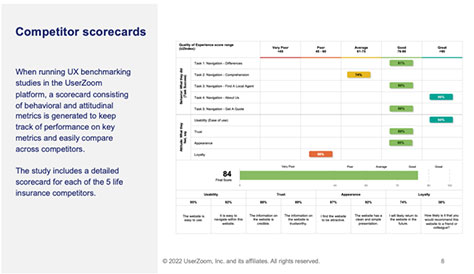So what do successful design-led organizations do? What’s their secret recipe? UX leaders continually test and iterate. We embed research throughout our product-development processes and make data-driven decisions. We also measure UX design performance and its impact on the financial success of the business. Furthermore, we live in a world of constant competition, in which every executive wants to know how their company ranks among its competitors. Seeing these rankings can be a motivational booster.
For example, imagine working in product design at a US life-insurance company and finding yourself in the elevator with its CMO (Chief Marketing Officer). You’d have ten seconds to make an impression. What if you were to reel off the measurable impacts of the revenue-critical journeys of your biggest competitors’ Web sites? Your CMO might react by asking, How so?
UserZoom’s Digital-Experience Benchmarking Study
In April 2022, UserZoom launched a competitive digital-experience benchmarking study, ranking the UX journeys of the Web sites of five US life insurers. We based our mixed-methods study on responses from 500 prospective life-insurance customers of Mutual of Omaha, Farmers Insurance, State Farm, Northwestern Mutual, and Prudential.
Our study examined the prospect’s revenue-critical journey through these insurance providers’ Web sites, as well as ratings regarding usability, trust, appearance, and loyalty. We ranked each insurer using UserZoom’s proprietary QXscore benchmarking system, which combines observed-behavior task success alongside attitudinal measures such as usability, or ease of use; trust, appearance; and loyalty, or Net Promoter Score (NPS), resulting in an easy-to-understand grade between 1–100. As Figure 1 shows, Mutual of Omaha’s Web site received the highest QXscore for revenue-critical user journeys, 84 out of 100; while Northwestern Mutual’s Web site received the lowest QXscore of 73/100. Figure 2 shows some competitor scorecards.


Now, if you were sitting with insurance executives at the top table in the CMO’s office and could explain why Northwestern Mutual’s Web site scored the lowest, the CMO might ponder how you could tie this QXscore—which includes NPS—to financial metrics. The CMO might also consider how to connect the QXscore to the company’s key business metrics to justify incremental investments in UX design and research.

